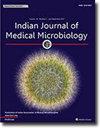Vulvovaginal candidiasis in pregnant women attending a tertiary care centre in North-Eastern India
IF 1.4
4区 医学
Q4 IMMUNOLOGY
引用次数: 0
Abstract
Background
Candida colonisation in vagina was found to be 20 %, rising to 30 % during pregnancy. According to studies, the prevalence of VVC during pregnancy is higher than healthy women. During pregnancy, candidal colonisation increases, both symptomatic and asymptomatic. However, the difference between strains causing symptomatic infection and those that cause asymptomatic infection is unknown.
Objective
This study aimed to compare the virulence factors of Candida VVC isolates from symptomatic and asymptomatic pregnant women.
Methods
The study included 120 pregnant women- 60 symptomatic and 60 asymptomatic, who presented to the Obstetrics and Gynaecology Outpatient Department with vaginitis symptoms. High vaginal swabs from the patient and used for gram stain, direct wet mount, pH detection and fungal culture in SDA with and without antibiotics. Germ tube tests, growth in CMA, and HiCrome Candida Differential Agar were used to identify yeast colonies grown in culture. The isolates were then examined for virulence factors like biofilm formation, phospholipase, coagulase, and hemolysin. Antifungal susceptibility was determined using E-test.
Results
The current study reveals a high prevalence of Vulvovaginal Candidiasis in pregnant women(35 %). Asymptomatic patients had lower proportion of VVC than symptomatic patients. Non albicans Candida(NAC) outnumbered Candida albicans. Although Candida albicans growth was predominant in asymptomatic patients. Virulence studies revealed that Candida spp. isolated from symptomatic patients expressed a higher proportion of virulence factors. Besides NAC has higher proportion of expressing virulence factors than Candida albicans and has higher propensity to cause infection especially in symptomatic pregnant women. Antifungal susceptibility testing shows Itraconazole to be most sensitive for VVC treatment but Candida albicans was most susceptible to fluconazole while NAC had the least.
Conclusions
The study emphasizes the importance of routine screening of symptomatic pregnant women for VVC, as syndromic treatment will increase antifungal resistance, particularly in NAC.
在印度东北部一家三级医疗中心就诊的孕妇患有外阴阴道念珠菌病。
背景:研究发现,念珠菌在阴道中的定植率为 20%,而在怀孕期间则上升至 30%。研究表明,孕期阴道念珠菌感染率高于健康妇女。在怀孕期间,念珠菌的定植率会增加,无论是有症状还是无症状。然而,引起无症状感染的菌株与引起无症状感染的菌株之间的差异尚不清楚:本研究旨在比较从有症状和无症状孕妇中分离出的 VVC 念珠菌的毒力因子:研究对象包括 120 名因阴道炎症状到妇产科门诊就诊的孕妇--60 名有症状和 60 名无症状。取患者阴道高位拭子进行革兰氏染色、直接湿装片、pH 值检测,并在使用或不使用抗生素的情况下在 SDA 中进行真菌培养。菌管试验、CMA 生长和 HiCrome 念珠菌差异琼脂用于鉴定培养物中生长的酵母菌菌落。然后检测分离物的毒力因子,如生物膜形成、磷脂酶、凝固酶和溶血素。抗真菌药敏性采用 E 测试法确定:本次研究显示,孕妇外阴阴道念珠菌病的发病率很高(35%)。无症状患者患外阴阴道念珠菌病的比例低于有症状的患者。非白色念珠菌(NAC)多于白色念珠菌。尽管在无症状患者中白念珠菌的生长占主导地位。毒力研究显示,从无症状患者体内分离出的念珠菌属表达毒力因子的比例较高。此外,南美念珠菌属表达毒力因子的比例高于白念珠菌属,尤其在有症状的孕妇中更易引起感染。抗真菌药敏试验显示,伊曲康唑对治疗 VVC 最为敏感,但白念珠菌对氟康唑的敏感性最高,而 NAC 的敏感性最低:本研究强调了对有症状的孕妇进行 VVC 常规筛查的重要性,因为综合治疗会增加抗真菌耐药性,尤其是对 NAC 的耐药性。
本文章由计算机程序翻译,如有差异,请以英文原文为准。
求助全文
约1分钟内获得全文
求助全文
来源期刊

Indian Journal of Medical Microbiology
IMMUNOLOGY-
CiteScore
2.20
自引率
0.00%
发文量
154
审稿时长
73 days
期刊介绍:
Manuscripts of high standard in the form of original research, multicentric studies, meta analysis, are accepted. Current reports can be submitted as brief communications. Case reports must include review of current literature, clinical details, outcome and follow up. Letters to the editor must be a comment on or pertain to a manuscript already published in the IJMM or in relation to preliminary communication of a larger study.
Review articles, Special Articles or Guest Editorials are accepted on invitation.
 求助内容:
求助内容: 应助结果提醒方式:
应助结果提醒方式:


